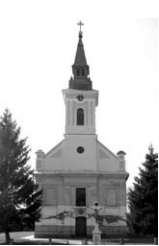Roman Catholic Church The Assumption of the Virgin with its late Baroque stylistic features, was built between 1760 and 1770. It was built with the donation of the noble family Vojnić who received the nobleman’s leaf and the coat of arms in 1741, and in 1759 he bought from the Zako family half of Bajša.
The church is designed as a one-nave building from the outside five-sided, and from the inside with a semicircular apse and sanctuary that is lower than the nave. The sacristy is attached to the left side. In addition to the longitudinal walls of the naos, two pointed pilasters were placed on which are arches bearing spherical vaults. This resulted in a razed inner space divided along the grass. In the western part of the church there is a belfry with wide, arched windows. The chorus is newer, on thin, iron pillars that are very simple shapes. On the façade was made rizalit flanked pilasters. Above the main entrance to the temple is a relief embossed coat of arms. The side facades of the temple are made without any plastic, just around the window are simple frames and a simple solbank. On the surface of the bell tower there are two smaller windows one above the other. There are two tombstones of the ktitor family in the church.The Icon of the Virgin, the work of Jozef Šmit from 1816. The Virgin is shown in a kneeling position, in a semicircle to the right, extended arms. Down to the right is the angel, his arms and wings spread, facing the back of the viewer. Between these two main figures there are two heads of angels in the clouds. Statues, expressions, abrupt movements, contrasting colors, light and dark relationships have been realized in Baroque reminiscences.
On the right side altar there is a picture of the gospel Mateja, the work of an unknown author. The saint is shown in a standing position, with the gospel on the floor, behind is an angel. The production time data and the author could not be more specific.
Fourteen images of Via Crusis are original painting work, originated around the middle or the second half of the 19th century. Correct drawing, rich and complex compositions, figures in a less pronounced sfumat, coloration of predominantly cold tones, muted with gray, all reminds of the works of local masters of the 19th century, for example, Jovana Klajic, but it is getting more and more crafty here.
Statue of the Virgin with Christ – is made in wood. The Virgin holds a short scepter in the right hand. After the stylization of the line, in the form of a skipper, it can be concluded that the work of the 18th century, although it was renewed, overturned and lacquered, lost its originality.
Crucifixion of Christ – also work in the tree. By the type of Christ’s character, the fabric around the thighs, the line of figures, the work could be dated in the 18th century.
It’s a gilt-silvered dress, a classicist conception. The base is a regular circle; the base is the main ornament astragal and stylized sheet, palms, then the frieze of ring shapes covering one after the other, behind it is astragal. The older monsters, of lesser precious material, possibly gilded, have the shape of the base and ornaments on it in the style of the hand. It is not certain whether these monsters (also found in the Roman Catholic Church in Odzaci) are serial works of the 18th century, or the second half of the nineteenth century.
The baptismal and preaching rooms, according to plastic carved decoration, are probably works from the 19th century.
ROMAN CATHOLIC CHURCH OF THE ASSUMPTION OF THE VIRGIN


0 comments on “ROMAN CATHOLIC CHURCH OF THE ASSUMPTION OF THE VIRGIN”